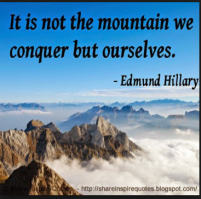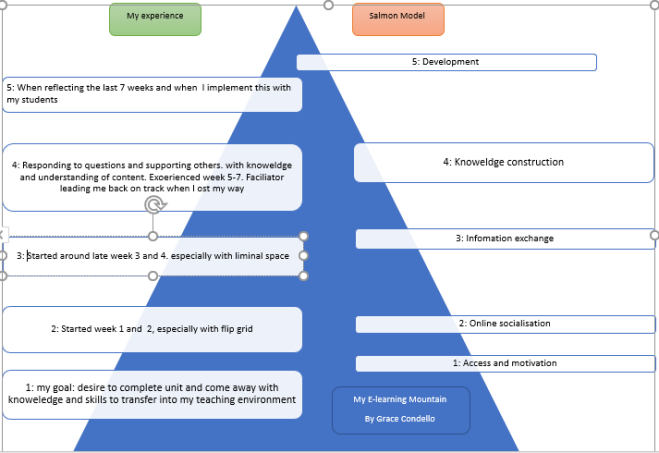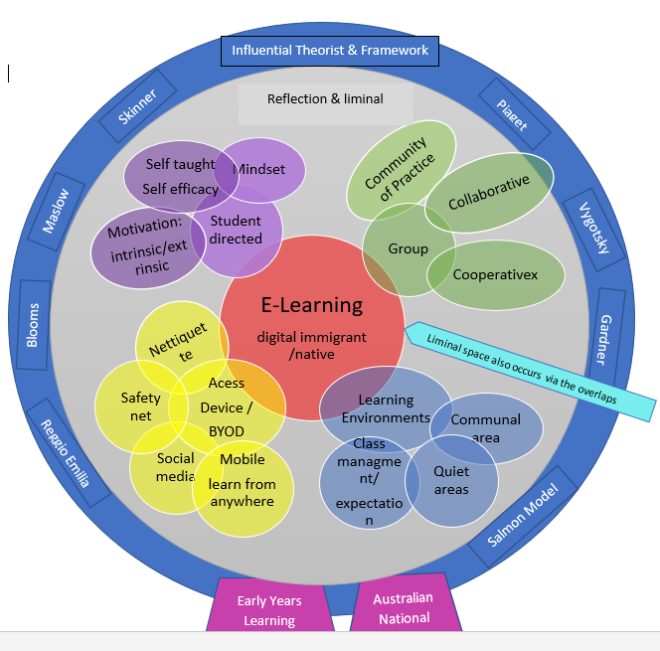 I anticipated uploading Flipgrid as my introduction, I choose Voki! it hides imperfections (only ‘perfect’ posts upload to social media,). Actually, learning spaces is also imperfect! and rightfully so, with new students and perceptions (student voices) changing ongoingly (QIP plan, ACECQA ). When considering Flipgrid, I recalled the sense of failure looming. Yet, I must complete my degree! (Salmon’s first stage, ‘motivation’). Unbeknown, experiencing ‘the liminal‘.
I anticipated uploading Flipgrid as my introduction, I choose Voki! it hides imperfections (only ‘perfect’ posts upload to social media,). Actually, learning spaces is also imperfect! and rightfully so, with new students and perceptions (student voices) changing ongoingly (QIP plan, ACECQA ). When considering Flipgrid, I recalled the sense of failure looming. Yet, I must complete my degree! (Salmon’s first stage, ‘motivation’). Unbeknown, experiencing ‘the liminal‘.
Flipgrid was trouble-free (stage one, ‘access’), shortly receiving words of encouragement, together with Salmons (2011) reading, I was heading into stage two, ‘online socialization’. Week three simulated a cohort in collaboration, we shared digital technology ideas and established a community of practice. Venturing into the liminal space, ironically led to simultaneously, experiencing what I’m learning. I thought I’d gone back to stage two, however, when I had a better understanding, I began to assist others, establishing stage three, ‘information exchanging.’
Stage four provided a sense of belonging and acceptance, posts are acknowledged (EYLF, 2009). Whilst initially, facilitators’ prompted this, the cohort took ownership. At times when I went off track, facilitators guided me back.
The Salmon Model is a framework which supports facilitators and students with online learning. This was my journey, like climbing a mountain~

 I believe students benefit from understanding Salmon’s model and processing their own learning. Implementing a CoP with clear expectations and Netiquette ensures consistency and support. Digital technology provides flexibility to learn anywhere (Merewether, 2015). Salmon’s model establishes self-efficacy and student-directed pedagogy interconnecting with theories.
I believe students benefit from understanding Salmon’s model and processing their own learning. Implementing a CoP with clear expectations and Netiquette ensures consistency and support. Digital technology provides flexibility to learn anywhere (Merewether, 2015). Salmon’s model establishes self-efficacy and student-directed pedagogy interconnecting with theories.
Below is my diagram of E-learning:

RESOURCE
Reference
Australian Children’s Educational & Care Quality Authority (2018) Quality and Improvement Plan. retrieved from https://www.acecqa.gov.au/assessment/quality-improvement-plans
Bailie, C., Land, R. and Meyer, J. (2010). Threshold concepts and transformational learning. Rotterdam: Sense Publishers. Retrieved from https://www.lamission.edu/learningcenter/docs/1177-threshold-concepts-and-transformational-learning.pdf
Biddick, N. (2014). working in open plan learning spaces. Teacher Learning Network Newsletter. Victoria. 21 (1). p23-25, retrieved from http://web.b.ebscohost.com.ezproxy1.acu.edu.au/ehost/pdfviewer/pdfviewer?vid=1&sid=2eebbfb7-b35e-4cb2-8f40-c7914ecdc466%40pdc-v-sessmgr01
Cherry, K. (2017). Self-Efficacy: Why Believing in Yourself Matters. Retrieved from https://www.verywellmind.com/what-is-self-efficacy-2795954
David, L. (2015). “Classical and Operant Conditioning (Skinner),” in Learning Theories. Retrieved from: https://www.learning-theories.com/operant-conditioning-skinner.html.
Department of education and training, (2009). Belonging, Being and Becoming- The Early Years Learning Framework for Australia. Retrieved from https://docs.education.gov.au/documents/belonging-being-becoming-early-years-learning-framework-australia
Image of a mountain with salmon is by Grace Condello
Image of e-learning is by Grace Condello
image with a quote, referring conquering self and not mountain is retrieved from http://shareinspirequotes.blogspot.com/2013/05/it-is-not-mountain-we-conquer-but.html#axzz5RB63aXA8
Merewether, J. (2015). Young children’s perspectives of outdoor learning spaces: What matters? Australasian Journal of Early Childhood. 40(1), 99-108.
Pappas, P. (2010). The Reflective Student: A Taxonomy of Reflection (Part 2). Retrieved from https://peterpappas.com/2010/01/reflective-student-taxonomy-reflection-.html
Pew, S. (2007). Andragogy and Pedagogy as a Foundational Theory for Student Motivation in Higher Education. Student Motivation, 2, 17-18.
Salmon, G. (2011). E-moderating: the key to teaching and learning online 3rd ed. (pp. 31-55). New York: Routledge. Taylor & Francis Group
Selwyn N. (2016). Digital downsides: exploring university students’ negative engagements with digital technology. Teaching higher education Journal. Retrieved from https://srhe.tandfonline.com/doi/full/10.1080/13562517.2016.1213229?src=recsys#.W3er1egzY2x
Shea, V. (2014). Course netiquette and guidelines. Teaching online. Retrieved from http://www.epigeum.com
Smith, M. (2003/2009). Jean Lave, Etienne Wenger, and communities of practice. The encyclopedia of informal education. Retrieved from http://infed.org/mobi/jean-lave-etienne-wenger-and-communities-of-practice/\
Smith, M. (1996). Self-direction in learning. Retrieved from http://infed.org/mobi/self-direction-in-learning/
Video on 5 stage model. Centre for education facility (2016)UWA Educational Enhancement Unit. Carpe diem- 5 stage model professor gilly salmon. Retrieved from https://www.youtube.com/watch?time_continue=4&v=ILCnUgfeuoc
